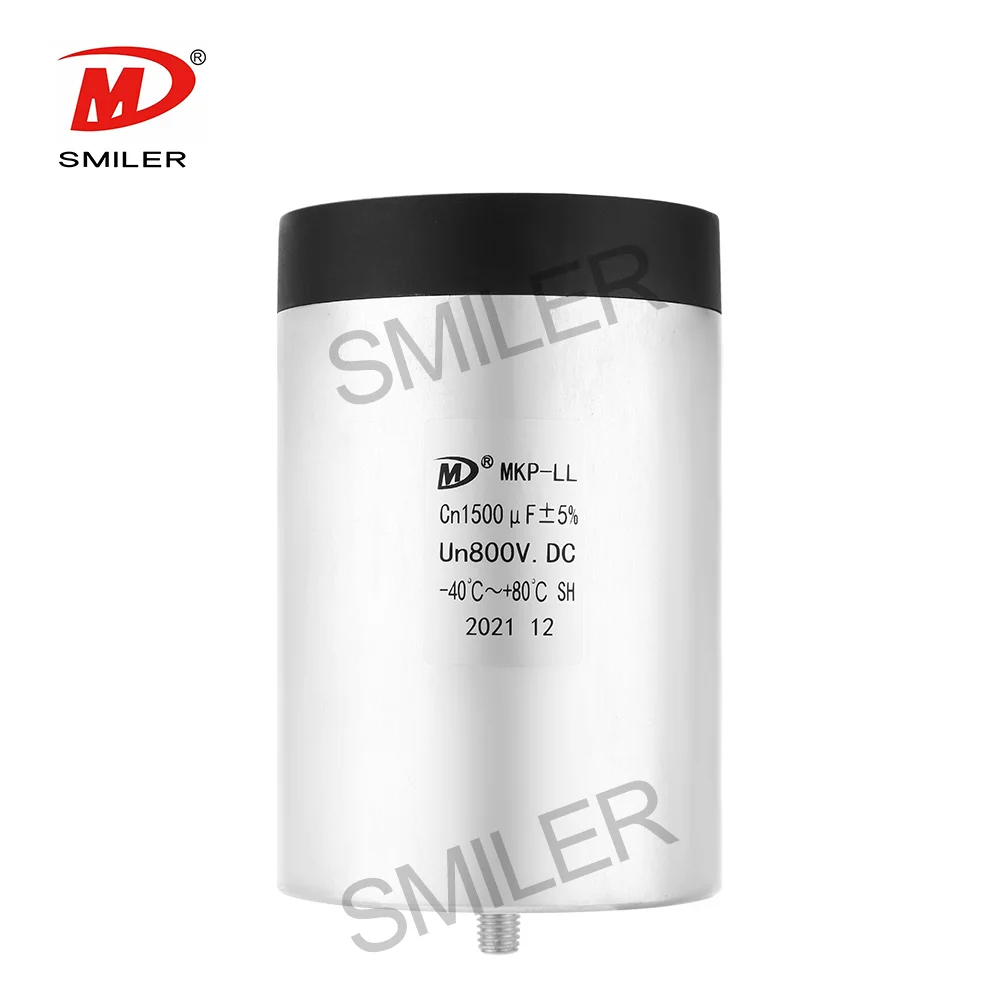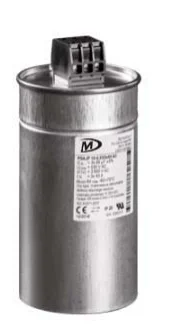
A capacitor typically consists of an insulator with two metal plates mounted on both sides of the insulator. The positive and negative charges are transferred inside the conductor when electricity flows. The charges are transferred through the capacitor when electricity is being supplied, but the movement of charges is limited by the insulator between the metal plates. Therefore, the charges are kept in one of the two metal plates and the second plate is given an opposite charge.
Capacitors serve in electric circuits by storing electrical energy efficiently and dependably using two conductive plates separated with an insulation medium known as the dielectric layer.
One standout product in SMILER’s lineup is the DC Link MKP-LL capacitor which is crafted with a polypropylene film housed in an aluminum shell package for optimal performance and durability. It is used in DC-Link circuits and can replace electrolytic capacitors. This capacitor design makes it ideal for a range of applications including inverters used in wind and solar power systems due to its efficiency and reliability features.
A capacitor is an electronic component that stores and releases electricity in a circuit. The capacitors play a crucial role in smoothing out voltage fluctuations and providing stability to circuits. It also passes alternating current without passing direct current.
Capacitors can charge and discharge because of the structure. Featured by the electric charge and discharge, capacitors also can be used as a power supply. Camera flashes utilize this feature of capacitors.
Capacitors are also used to maintain the voltage at a certain level. They are useful in reducing the voltage pulsation. When a high voltage is applied to the parallel circuit, the capacitor is charged and conversely, it is discharged with the application of a low voltage. While the electricity flowing out is AC, most electronic circuits work with DC. Therefore, AC is converted into DC using a rectifier circuit. However, the converted DC is an unstable current that includes ripples. A capacitor is used to remove these ripples and maintain a constant voltage.
The flow of AC in a capacitor is useful for noise reduction. In general, since the noise in DC is an AC component with high frequency, it tends to go through the capacitor easily. A branch circuit is inserted between the input and output to form a ground connection in the capacitor.
SMILER's DC-Link Capacitor excels with its low ESR, high ripple current handling capabilities, self-healing properties and long lifetime, making it a reliable choice for transportation applications like EVs or HEVs.

Capacitors have a feature where they can let alternating current (AC) flow through while stopping direct current (DC). This ability comes from how they're built to charge and discharge based on the changing direction of AC signals. SMILER’s AC-Filter Capacitor MKP-AL showcases this feature well in action. It is made for filtering AC and handling high-frequency harmonics with good heat dissipation and compact size, so it is ideal for different power systems and energy storage equipment.
When dealing with DC circuits in electronic systems, capacitors play a role by serving as obstacles that hinder the consistent movement of electric charge through their dielectric material layer. Once these capacitors are charged up with electricity. Hold onto it tightly like a barrier wall does to keep things out or in place until they release it all at once when required. The designed DC link Capacitors from SMILER are known for their exceptional capability in this aspect. They are crafted to take over the job of electrolytic capacitors, in DC link setups by providing unmatched performance across voltage ranges spanning from 600 volts to 4000 volts DC and offering capacitance precision choices of either ±5 % or ±10 %.
Capacitors play a role in power supply setups by controlling energy flow and maintaining voltage stability. Serving the purpose of storing energy and delivering it when required ensures a steady power source even when there are fluctuations. SMILER's DC link Capacitor excels in scenarios as it is engineered to substitute electrolytic capacitors in DC link circuits. It also possesses performance specifications with voltage values ranging from 600 VDc to 4000 VDc and capacitance tolerance levels of ±10 % or ±10 %. It suits applications in wind energy and solar energy inverters where stable voltage is crucial.
Capacitors, in communication and signal processing, serve the purpose of lowering interference and ensuring more clear signals. They work by blocking DC elements while permitting AC signals to transmit smoothly resulting in better signal quality. The AC Filter Capacitor MKP-AL by SMILER is custom-built for these tasks. It boasts heat dissipation, a lightweight design and a compact size making it ideal for reactive power correction and a range of low-voltage parallel circuits. The dual security feature guarantees dependability in challenging conditions with both a protective mechanism and a built-in overpressure safety cutoff system in place.
SMILER is a company in the field of capacitor technology with advanced and automated production lines that are known for their efficiency and precision in manufacturing processes while maintaining high-quality standards consistently above 99.93%. With a production capacity of 300,000 units and a rigorous focus on innovation and quality, SMILER has become a reputable supplier of innovative capacitors for a range of applications. SMILER’s DC link capacitors are widely used in wind power generation. They support 1500VDC systems (such as the 680µF/1500VDC model), match the converter requirements of offshore wind turbines above the 10MW level and reduce the voltage stress of the IGBT module.
A: SMILER’s DC-Link Capacitors are made to optimize the circuit's performance by substituting traditional electrolytic capacitors in DC-Link applications. They exhibit low ESR, high ripple current capability and self-healing, ensuring extended life and reliability. These capacitors are widely applicable in renewable energy systems such as wind and solar systems, where they stabilize voltage levels and help in effective energy conversion processes.
A: SMILER’s AC Filter Capacitors are specifically designed for filtering AC. Processing high-frequency harmonics efficiently in industrial settings that call for reactive power compensation and noise reduction solutions. They boast excellent heat dissipation capabilities along with being lightweight and compact. These qualities make them perfect for various industrial applications. The capacitors offer dual protection mechanisms to ensure safety and reliability in challenging working conditions. One of these features includes a secondary protection device while the other is a built-in overpressure cut-off protection system.
A: The atactic copolymer PP offers a suitable melt flow rate (MFR 70–90), enabling the efficient creation of thin, consistent films during manufacture. This yields a consistent dielectric layer crucial to capacitor operation. The block copolymer PP offers impact strength and low-temperature stability, featuring resistance to film brittleness or cracking in extreme environments. This enhances the reliability of the capacitor when subjected to heat or mechanical stress. Polypropylene's chemical inertness and high transparency of atactic copolymers suggest low impurities, reducing energy loss and improving electrical insulation properties.